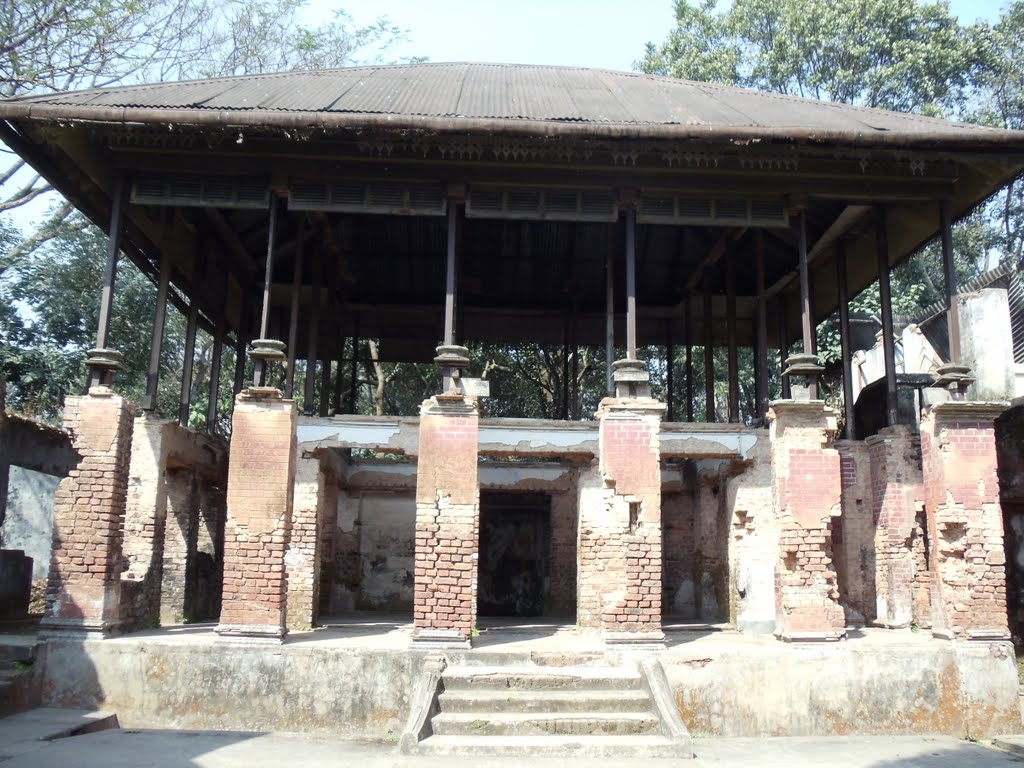Muktagachha Palace
Overview of Muktagachha Palace
The Muktagachha zamindars of Mymensingh were well known in this sub-continent for the various work they did and luxurious lives. People of the district remember them with respect for their contributions, especially to the education sector. Muktagachha is now a merely an upazila sadar, though at one stage 16 of the zamindar inheritors controlled their administration from this place. History says that Sree Krishna Acharya Chowdhury of Bogra was the first to establish zamindari here. He took on lease Alepshahi Pargana (estate) one of the 22 estates of Bengal in 1727 from Nawab Alibardi Khan. Later, the three parganas: Alekshahi, Momenshahi and Hossainshahi were merged into after the death of Isha Khan. It was after the merger that Sree Krishna Acharya obtained the zamindari of Alepshahi estate from Murshidabad on obtaining it, Sree Krishna returned to Muktagachha by boat along the Brahmaputra river. Mukta Ram -- a poor and humble artisan -- welcomed him with the presentation of a brass lampstand. This gesture kept alive Mukta Ram's name and the zamindar's palace was named Muktagachha. Its previous name was Binod Bari. The area at the time was hilly and full of forests abundant with wild animals. Only a few fisher families lived there. Later, Sree Krishna allowed immigrants to settle in and start cultivation. Zamindar Sree Krishna had four sons -- Ram Ram, Hori Ram, Bishnu Ram and Shiva Ram. Raghu Nandan the son of Shiva Ram allotted necessary land for the establishment of Mymensingh town in 1787. Later on, Gouri Kanta, Kashi Kanta, Suryo Kanta and Shashi Kanta -- Shiva Ram's next generation -- made greater contributions to upgrade the name and fame of zamindars of Muktagachha. Jagat Kishore Acharya Maharaja was another influential among the zamindars. He was the son of Hori Ram and a zamindar of Aatani (half portion) of the total estate. Kumar Jeetendra Kishore and Kumar Bhupendra Kishore were Jagat Kishore's sons. Jeetendra had a great liking for music while Bhupendra was devoted to drama. Raja Jagat Kishore constructed an opera house titled Bhupendra Rangapith with a revolving stage. It was the second revolving stage in the Indian sub-continent. Jagat Kishore had a collection of over 10,000 books in his library -- the largest in East Bengal. After the partition in 1947, the books were handed over to the Bangla Academy as "Muktagachha Collection". Jagat Kishore started Bidyamoyee Girls High School, which still retains its fame as a government girls school and Ram Kishore High School at Muktagachha after his mother Bidyamoyee Devi and father Ram Kishore. Suryo Kanta's lodge is now being used as Muktagachha Shaheed Smriti Govt College. Various institutions still bear testimony of Suryo Kanta. Such are Raj Rajeswari Water Works, Shashi Lodge, Alexandra Castle, Suryo Kanta Hospital and the Town Hall. Suryo Kanta also donated land worth Tk two lakh to construct the Dhaka-Mymensingh railroad. Suryo Kanta was very hospitable person. Many famous personalities of the then Indian sub-continent and outside visited his palace on various occasions. Lord Curzon, the British government representative, in a letter on February 17, 1902 wrote: "I must in leaving, write you a brief line of thanks for your hospitable entertainment to me during the last two days and regret that your illness has prevented you from taking any part in it. I should have greatly enjoyed your company both here and in Gour." The zamindars of Muktagachha constructed many temples, puja mondaps, made large ponds, gardens and nat mondirs for their subjects. But with the passage of time, memories of the zamindar's palaces and other establishments go into oblivion, because of lack of repairs and maintenance. It is difficult to even recognise that these ruined palaces were once used by zamindars, whereas all the palaces had super luxuries with various moments along with herds of elephants. But reality is that bushes, shrubs and creepers have covered the once beautiful yards of the palaces. It is way beyond anyone's imagination that human beings dwelled in these palaces. Today there is no sign of the houses of Shashi Kanta and his son Jibendra Kishore. Miscreants broke down the walls and pillars of Jibendra Kishore's house when they heard that five bricks made of gold were hidden in the house. The house where the elephants were kept, dungeons, revolving stage, courts, the places where the mummified skulls of elephants head and the bodies of two Royal Bengal Tigers were preserved, have gone on the verge of extinction. Bats are seen flying in and out of these old establishments. The Archeological Department took the charge of the palaces of Muktagachha about 12 years back but no work has yet been done. Visitors enter the palaces everyday only with permission from the authorities concerned. As the young people move here and there, accidents may take place at any moment because of the dilapidated condition. The palaces could be an attractive tourist spot with a source of income. Immediate efforts must be made to preserve our past glory for the future generations. Story: Aminul Islam, (C) Copyright thedailystar.net
Copyright notice: Some contents and images are taken from wikipedia.org (under GNU-FDL) and copyright goes to wikipedia.org and other source sites, photographers and article writers.
Life is a moderately good play with a badly written third act.
Truman Capote (1924 - 1984)










